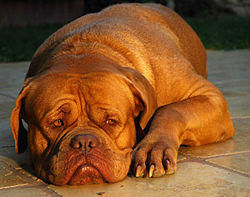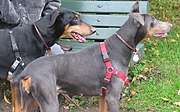History
The Dogue de Bordeaux was known in France as early as the fourteenth century particularly in southern France in the region around Bordeaux. Hence, the city lent its name to these large dogs.A uniform breed type of the Bordeaux Dog did not exist before about 1920. The French placed emphasis on keeping the old breeding line pure. Black masks were considered an indication of the crossing in of the Mastiff (English Mastiff). As an important indication of purity of the breed, attention was paid to the self colored (pink) nose, lighter eye color (dark amber), and red mask. Originally bred with huge anatomically incorrect heads; a pioneer for the breed in Germany, Werner Preugschat once wrote:
"What am I supposed to do with a dog that has a monstrous skull and is at most able to carry it from the food dish to its bed."
The Dogue de Bordeaux was at one time, known to come in two varieties, Dogues and Doguins, the former, the Dogue, being a considerably larger dog than the latter. The latter, the Doguin, has withered away to nothing more than a mention in breed history books, as it is no longer in existence.
The history of the breed is believed to predate the Bullmastiff and the Bulldog. It is said that the Dogue can be found in the background of the Bullmastiff, and others claim that the Dogue and Mastiff breeds were both being accomplished at the same time. Another theory is the Dogue de Bordeaux originates from the Tibetan Mastiff and it is also said that the Dogue is related to the Greco Roman molossoids used for war, as there was a breed similar to the Dogue de Bordeaux in Rome at the time of Julius Caesar's reign, possibly a cousin of the Neapolitan Mastiff. Others suggest that the Dogue de Bordeaux is a descendent of a breed which existed in ancient France, the Dogues de Bordeaux of Aquitaine. Which ever theory is true, it is obvious that the Dogue de Bordeaux shares the same common links as all modern molossers.
The Dogue de Bordeaux was once classified into three varieties, the Parisian, the Toulouse and the Bordeaux, types which were bred depending on the region of France and the jobs they were required to do. Ancestral Dogues de Bordeaux had various coat colors, such as brindle and majority of white markings that carried fully up the legs. They had scissor bites in some regions, undershot in others, big heads, small heads, large bodies and small bodies, very inconsistent in type. Another controversial aspect was the mask, red (brown), none or black. The Dogues de Bordeaux of Bordeaux of the time also sported cropped ears. Regardless, they all had a general type similar to today's Dogue de Bordeaux.
In 1863 the first canine exhibition was held at the "Jardin d'Acclimatation" in Paris, France. The winner of the Dogue de Bordeaux was a bitch named Magentas. The Dogue de Bordeaux was then given the name of the capital of their region of origin, today's Dogue de Bordeaux.
The Dogue de Bordeaux was used as a hunter, a herding dog, and a guardian. They were trained to bait bulls, bears, and jaguars, hunt boars, herd cattle, and protect the homes, butcher shops, and vineyards of their masters. The Dogue de Bordeaux was prized as protectors and was often found in the homes of the wealthy of France. A setback in the breed came during the French Revolution when many of the Dogues de Bordeaux perished with their wealthy masters. The Dogues de Bordeaux of the common man have thrived. These became champions, and were powerful dogs bred to do their jobs and do them well. Another setback for the breed was during World War II, Adolf Hitler was said to have demanded the execution of all Dogues de Bordeaux because of their devout loyalty to their owners[citation needed].
During the 1960s, a group of breeders of the Dogue de Bordeaux in France, headed by Raymond Triquet, worked on the rebuilding of the foundation of the breed. In 1970 a new standard was written for the breed, with the most recent update in 1995. This standard is the basis of the standard written for the AKC in 2005.
Although the Dogue de Bordeaux first came to the USA in the 1890s for the show ring, the first documented Dogues de Bordeaux of modern times was in 1959, Fidelle de Fenelon, and in 1968, Rugby de la Maison des Arbres. Between 1969 and 1980 imported Dogues de Bordeaux in the USA were scarce, limited to a few breeders who worked closely with the French Dogue de Bordeaux Club, the SADB. In the 1989 the typical American family saw the Dogue de Bordeaux for the first time on the big screen in Touchstone's movie Turner & Hooch about a police man and his canine partner, although many people did not know that the massive slobbering animal was a Dogue de Bordeaux.
Since then the Dogue de Bordeaux has taken hold in the United States and can be found in greatly increasing numbers across the country. The Dogue de Bordeaux has been supported by multiple breed clubs throughout the years, and has finally found its way to full AKC recognition through the assistance of the Dogue de Bordeaux Society of America. Since 1997 the DDBSA has helped bring the breed to the point in which full AKC recognition could be achieved.
The Dogue de Bordeaux has begun to flourish is recent years, with the introduction of them into more movies and even television, as well as their full recognition status by the American Kennel Club, also known as the AKC (full AKC recognition began July 2008). Their numbers are climbing, but careful attention must be paid to temperament and health in the breed, if the increase in popularity is to progress this breed in a positive forward motion in years to come.
- Beasley, who played the title role of Hooch in Turner & Hooch.
- Foster, who was the Spencer family dog on General Hospital.
- Mac, owned by Dutch footballer Andy van der Meyde, famously stolen and found in 2006.
- Kalusha De El Siscar, a female, appeared with Sarah Jessica Parker in Sex and the City.
- England Football player Frank Lampard owns several Dogues de Bordeaux and has offered several puppies of the same breed to Chelsea FC fans.
- English TV presenter Paul Ross has a Dogue de Bordeaux which appeared in Your dog magazine.
- Edward Norton's character in The Italian Job had Dogues guarding his estate.
- Mel Gibson's girlfriend in the movie Payback had a Dogue de Bordeaux, named Porter.
- Mr Wiskers from the Godtube show Dave the nerd.











